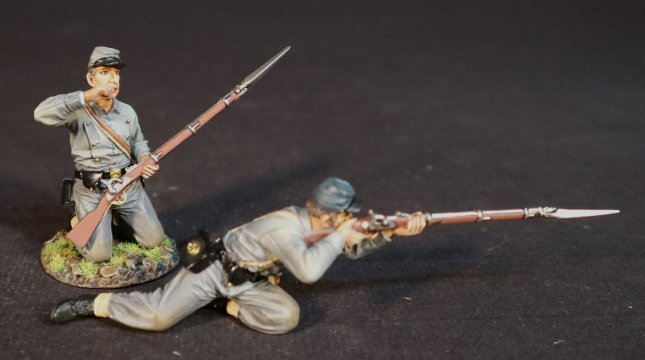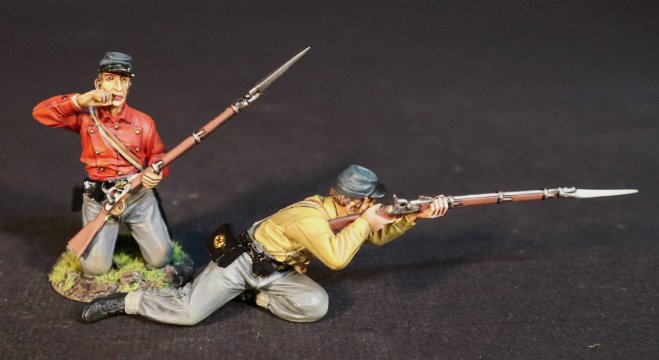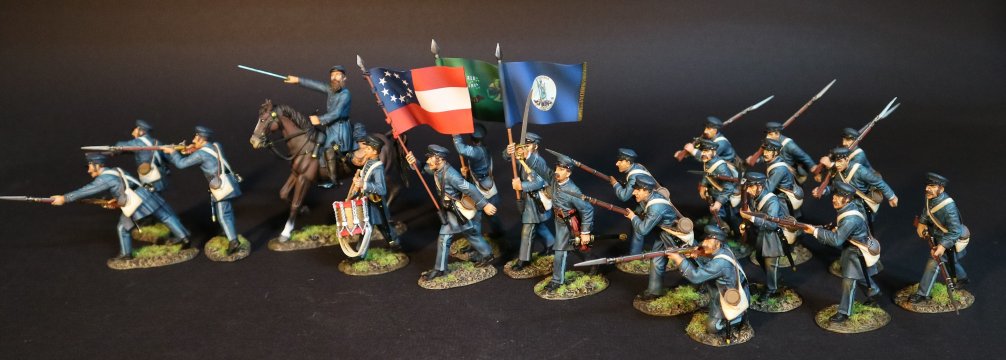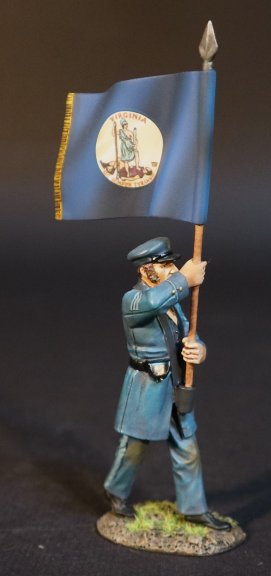- Joined
- Feb 2, 2011
- Messages
- 2,354
NEW RELEASES FOR FEBRUARY 2024
THE AMERICAN CIVIL WAR
1[SUP]st[/SUP] CHEROKEE MOUNTED RIFLES
The 1[SUP]st[/SUP] Cherokee Mounted Rifles was a Confederate States Army regiment which fought in the Indian Territory during the American Civil War.
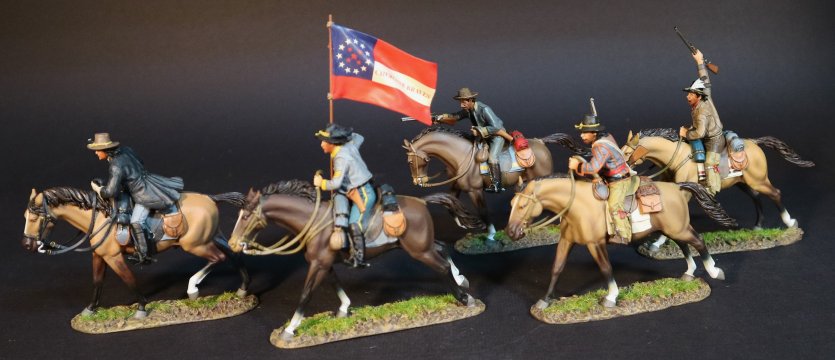
It was formed from the merger of two predecessor units, the First Regiment of Cherokee Mounted Rifles and the Second Regiment of Cherokee Mounted Rifles.
The first commander was Col. John Drew, while the commander of the second regiment was Stand Watie.
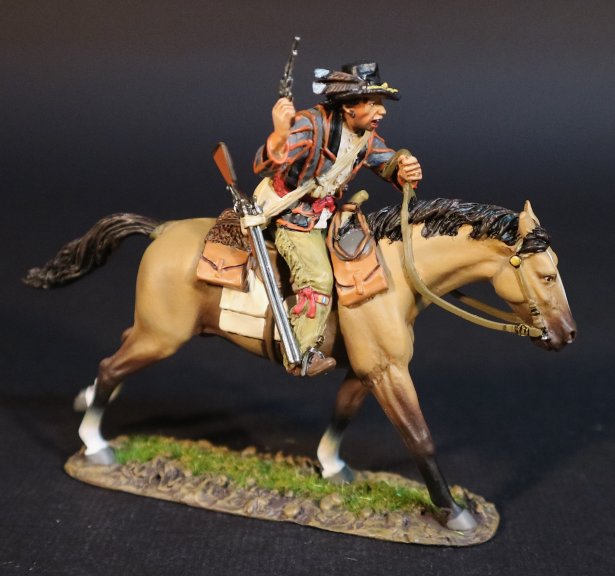
CHK-03
THE AMERICAN CIVIL WAR 1861 - 1865
THE CONFEDERATE ARMY,
1[SUP]st[/SUP] CHEROKEE MOUNTED RIFLES,
TROOPER.
Brigadier-General Stand Watie (December 12[SUP]th[/SUP], 1806 – September 9[SUP]th[/SUP] 1871) was a Cherokee politician who served as the second principal chief of the Cherokee Nation from 1862 to 1866.
The Cherokee Nation allied with the Confederate States during the American Civil War and he was the only Native American Confederate General officer of the war.
Watie commanded the forces in the Trans-Mississippi Theatre, made up mostly of Cherokee, Muskogee and Seminole.
He was the last Confederate Staes Army general to surrender.
During the Civil War, Watie's troops participated in twenty-seven major engagements and numerous smaller skirmishes. Although some of the engagements were set-piece battles, most of their activities utilized guerrilla tactics.
The Battle of Pea Ridge (March 7-8[SUP]th[/SUP], 1862) took place near Leetown, northeast of Fayetteville, Arkansas.
Pea Ridge was the first sizable battle of the Civil War to involve Native American troops, mostly because their current homeland lay only a few miles west of the battlefield. These Tribes, including the Cherokee, had lived in the Indian Territory, now the state of Oklahoma, ever since their removal from ancestral homelands in the southeastern states a quarter-century before the war.
Watie’s Mounted Rifles welcomed the opportunity to participate in the Pea Ridge Campaign, as it was a chance to show they were a worthwhile ally of the Confederacy.
They were to make a colourful and controversial contribution. During the battle the two Cherokee regiments, perhaps 1,000 strong along with 200 Texas cavalry, charged and took a three gun Union artillery battery.
They swept out of the woods, knocking down a fence in front of them, and charged across the field, swarming over a three gun battery before the startled crews could respond. The artillerymen fled with their horses, leaving the guns behind unspiked.
At this point experienced, disciplined troops would have established security, or continued the pursuit of their fleeing enemy. Neither was done. Instead the Cherokee milled around the guns they had taken, examining their prizes and collecting souvenirs. Others exhaulted in having survived, yelling and whooping victoriously.
It was a normal reaction for green troops after a first experience of combat, and one that was often repeated throughout those early years of the war.
The failiure of the officers to take charge of the situation was to cost them the fruits of their victory.
While the celebrations were taking place, Union officers deployed two additional batteries and supporting infantry to retake the guns.
The exploits of Stand Watie and his Confederate Mounted Rifles were brilliant and militarily glorious, but strategically sterile. Two years of raids could not loosen the Union grip on Fort Gibson.
The Cherokees not only were the most numerous of the Five Tribes, but they had assimilated more with white culture than the Choctaw, Creek, Chickasaw, or Seminole. They were the only Native Americans to create a written form of their language and they published a newspaper in that language. Many Cherokees adopted the white man’s dress and most began to utilize American farming methods. Cherokee lawyers brought cases defending their desire to remain in Georgia and North Carolina to the United States Supreme Court. A handful of elite Cherokees operated large plantations with African-American slave labor.
ARTILLERY
A typical “field piece” had an authorized crew of 12 enlisted men constituting a “gun section” led by a sergeant and assisted by one (and sometimes two) corporal. Each section consisted of one “gun,” its “limber” (with one ammunition chest also serving as a seat) and (nominally) six horses (but often only four) to pull it, and a “caisson” (with two ammunition chests/ seats, a spare wheel, tools, and crew baggage) with its own limber pulled by another six horses, and two “spare” horses (when available) tethered to the rear of the caisson. Each “vehicle” was known as a “half section.” Two sections under the command of a second lieutenant constituted a platoon.

While the platoon commander and the two section sergeants (there were no “platoon sergeants” at that time) rode their own assigned horses, six artillerymen rode the three left-side horses in each half section, while the remaining six privates either rode on the three ammunition chests (two to three per chest/seat) or walked alongside. Three platoons (sometimes only two, especially in Confederate units), plus a small headquarters, under a captain, assisted by a first lieutenant and a first sergeant, constituted a “battery.”
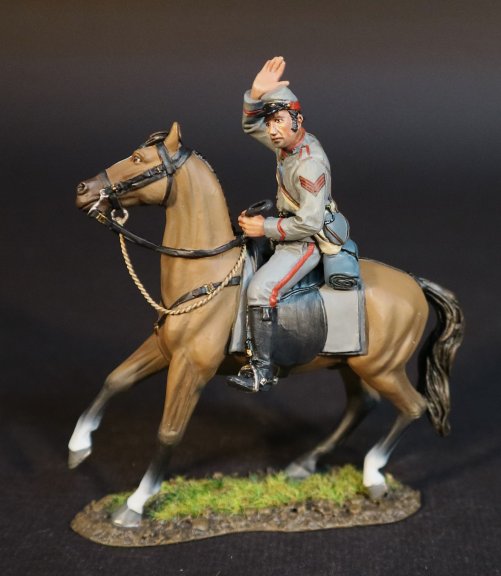
CSART-03
THE AMERICAN CIVIL WAR 1861 - 1865
CONFEDERATE ARTILLERY.
ARTILLERY SERGEANT
THE AMERICAN CIVIL WAR
1[SUP]st[/SUP] CHEROKEE MOUNTED RIFLES
The 1[SUP]st[/SUP] Cherokee Mounted Rifles was a Confederate States Army regiment which fought in the Indian Territory during the American Civil War.

It was formed from the merger of two predecessor units, the First Regiment of Cherokee Mounted Rifles and the Second Regiment of Cherokee Mounted Rifles.
The first commander was Col. John Drew, while the commander of the second regiment was Stand Watie.

CHK-03
THE AMERICAN CIVIL WAR 1861 - 1865
THE CONFEDERATE ARMY,
1[SUP]st[/SUP] CHEROKEE MOUNTED RIFLES,
TROOPER.
Brigadier-General Stand Watie (December 12[SUP]th[/SUP], 1806 – September 9[SUP]th[/SUP] 1871) was a Cherokee politician who served as the second principal chief of the Cherokee Nation from 1862 to 1866.
The Cherokee Nation allied with the Confederate States during the American Civil War and he was the only Native American Confederate General officer of the war.
Watie commanded the forces in the Trans-Mississippi Theatre, made up mostly of Cherokee, Muskogee and Seminole.
He was the last Confederate Staes Army general to surrender.
During the Civil War, Watie's troops participated in twenty-seven major engagements and numerous smaller skirmishes. Although some of the engagements were set-piece battles, most of their activities utilized guerrilla tactics.
The Battle of Pea Ridge (March 7-8[SUP]th[/SUP], 1862) took place near Leetown, northeast of Fayetteville, Arkansas.
Pea Ridge was the first sizable battle of the Civil War to involve Native American troops, mostly because their current homeland lay only a few miles west of the battlefield. These Tribes, including the Cherokee, had lived in the Indian Territory, now the state of Oklahoma, ever since their removal from ancestral homelands in the southeastern states a quarter-century before the war.
Watie’s Mounted Rifles welcomed the opportunity to participate in the Pea Ridge Campaign, as it was a chance to show they were a worthwhile ally of the Confederacy.
They were to make a colourful and controversial contribution. During the battle the two Cherokee regiments, perhaps 1,000 strong along with 200 Texas cavalry, charged and took a three gun Union artillery battery.
They swept out of the woods, knocking down a fence in front of them, and charged across the field, swarming over a three gun battery before the startled crews could respond. The artillerymen fled with their horses, leaving the guns behind unspiked.
At this point experienced, disciplined troops would have established security, or continued the pursuit of their fleeing enemy. Neither was done. Instead the Cherokee milled around the guns they had taken, examining their prizes and collecting souvenirs. Others exhaulted in having survived, yelling and whooping victoriously.
It was a normal reaction for green troops after a first experience of combat, and one that was often repeated throughout those early years of the war.
The failiure of the officers to take charge of the situation was to cost them the fruits of their victory.
While the celebrations were taking place, Union officers deployed two additional batteries and supporting infantry to retake the guns.
The exploits of Stand Watie and his Confederate Mounted Rifles were brilliant and militarily glorious, but strategically sterile. Two years of raids could not loosen the Union grip on Fort Gibson.
The Cherokees not only were the most numerous of the Five Tribes, but they had assimilated more with white culture than the Choctaw, Creek, Chickasaw, or Seminole. They were the only Native Americans to create a written form of their language and they published a newspaper in that language. Many Cherokees adopted the white man’s dress and most began to utilize American farming methods. Cherokee lawyers brought cases defending their desire to remain in Georgia and North Carolina to the United States Supreme Court. A handful of elite Cherokees operated large plantations with African-American slave labor.
ARTILLERY
A typical “field piece” had an authorized crew of 12 enlisted men constituting a “gun section” led by a sergeant and assisted by one (and sometimes two) corporal. Each section consisted of one “gun,” its “limber” (with one ammunition chest also serving as a seat) and (nominally) six horses (but often only four) to pull it, and a “caisson” (with two ammunition chests/ seats, a spare wheel, tools, and crew baggage) with its own limber pulled by another six horses, and two “spare” horses (when available) tethered to the rear of the caisson. Each “vehicle” was known as a “half section.” Two sections under the command of a second lieutenant constituted a platoon.

While the platoon commander and the two section sergeants (there were no “platoon sergeants” at that time) rode their own assigned horses, six artillerymen rode the three left-side horses in each half section, while the remaining six privates either rode on the three ammunition chests (two to three per chest/seat) or walked alongside. Three platoons (sometimes only two, especially in Confederate units), plus a small headquarters, under a captain, assisted by a first lieutenant and a first sergeant, constituted a “battery.”

CSART-03
THE AMERICAN CIVIL WAR 1861 - 1865
CONFEDERATE ARTILLERY.
ARTILLERY SERGEANT



